[1]
Xiaowu Hu, K.L., Zhixian Min Microstructure evolution and mechanical properties of Sn0. 7Cu0. 7Bi lead-free solders produced by directional solidification, Journal of Alloys and Compounds, 566(2013). 239–245.
DOI: 10.1016/j.jallcom.2013.03.034
Google Scholar
[2]
Y. Tang , G.Y.L., Y.C. Pan Influence of TiO2 nanoparticles on IMC growth in Sn–3. 0Ag–0. 5Cu–xTiO2 solder joints in reflow process, Journal of Alloys and Compounds, 554(2013). 195-203.
DOI: 10.1016/j.jallcom.2012.12.019
Google Scholar
[3]
Gupta, X.L.Z.A.M., Development of lead-free Sn–0. 7Cu/Al2O3 nanocomposite solders with superior strength, J. Phys. D: Appl. Phys., 41(2008).
Google Scholar
[4]
Si Chen, L.Z., Johan Liu, Yulai Gao and Qijie Zhai, A Reliability Study of Nanoparticles Reinforced Composite Lead-Free Solder, Materials Transactions, 51(2010). 1720-1726.
DOI: 10.2320/matertrans.mj201002
Google Scholar
[5]
S.M.L. Nai, J.W., M. Gupta Influence of ceramic reinforcements on the wettability and mechanical properties of novel lead-free solder composites, Thin Solid Films, (2006). 401 – 404.
DOI: 10.1016/j.tsf.2005.09.057
Google Scholar
[6]
Tsao, L.C., An investigation of microstructure and mechanical properties of novel Sn3. 5Ag0. 5Cu–XTiO2 composite solders as functions of alloy composition and cooling rate, Materials Science and Engineering A, (529)(2011). 41-48.
DOI: 10.1016/j.msea.2011.08.053
Google Scholar
[7]
S.M.L. Nai, J.V.M.K., M.E. Alam, X.L. Zhong, P. Babaghorbani, and M. Gupta, Using Microwave-Assisted Powder Metallurgy Route and Nano-size Reinforcements to Develop High-Strength Solder Composites, Journal of Materials Engineering and Performance, 19(3)(2010).
DOI: 10.1007/s11665-009-9481-z
Google Scholar
[8]
Jun Shen, Y.L., Dongjiang Wang and Houxiu Gao, Nano ZrO2 Particulate-reinforced Lead-Free Solder Composite, J. Mater. Sci. Technol, 52(2006). 529-532.
Google Scholar
[9]
A.A. El-Daly, A.F., S.F. Mansour , M.J. Younis Novel SiC nanoparticles-containingSn–1. 0Ag–0. 5Cu solder with good drop impact performance, Materials Science & Engineering A, (2013). 62–71.
DOI: 10.1016/j.msea.2013.04.022
Google Scholar


